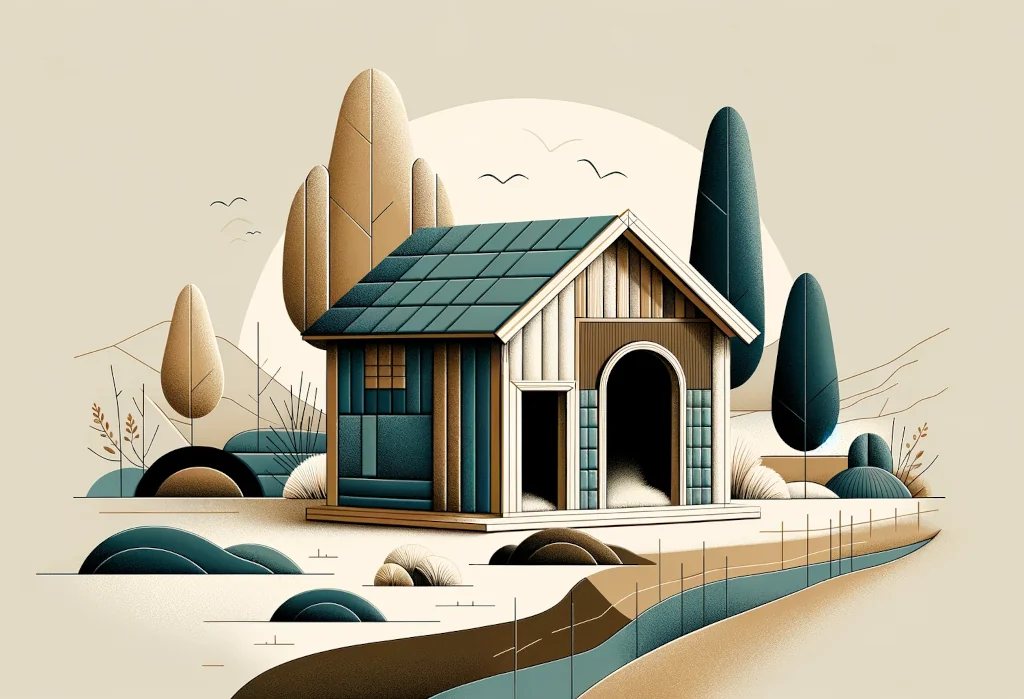
Winter is coming, and we’re not talking about a TV show—this is about keeping our furry friends snug and safe in their outdoor abodes. Picture this: your dog, tail wagging, stepping into a dog house that’s as cozy as your blanket-wrapped lap on a chilly evening.
In this post, you’re going to get the scoop on selecting the right materials and insulation to transform your pup’s outdoor haven from merely functional to fabulously cozy.
Quick Takeaways:
- Choose durable, non-toxic materials like wood or eco-friendly plastic for your dog house to ensure weather resistance and safety.
- Proper insulation, such as reflective materials and sealed cracks, is crucial for maintaining a comfortable temperature year-round.
- Regular maintenance, including adjusting bedding and ensuring effective ventilation, keeps the dog house welcoming and safe across all seasons.
What Should You Consider When Choosing Materials for an Outdoor Dog House?
When setting out to build an outdoor haven for your furry friend, several key factors must be taken into account to ensure their comfort, safety, and the structure’s durability. It’s like picking out materials for a mini home that needs to weather the seasons while keeping its occupant cozy and secure.
-
Weather Resistance: The material must withstand the elements — be it blistering sun, pouring rain, or biting frost. Look for materials that repel water, resist mold and mildew, and can hold their own against UV damage.
-
Durability: It needs to be tough. Your dog’s new home should stand the test of time, resisting wear and tear from both the elements outside and the dog inside. Chew-proof materials are a bonus if your dog enjoys gnawing on anything in sight.
-
Safety: This is non-negotiable. The materials shouldn’t have sharp edges or contain chemicals that could be toxic to your pet if ingested or inhaled. Natural, non-toxic materials are always a safe bet.
Moreover, the choice of material could also influence the thermal comfort inside the dog house and how energy-efficient it is to maintain a pleasant temperature for your pooch.
How Can You Ensure the Dog House Is Properly Insulated?
A well-insulated dog house is critical for keeping your dog warm during the winter and cool during the summer. Here are several effective strategies to achieve that cozy abode:
-
Choose Insulating Materials: Start with the right building materials. Wood, for example, has natural insulating properties. But here’s a twist: consider adding a layer of reflective insulation under the roof and around the walls. This type of insulation reflects radiant heat, keeping the dog house cooler in summer and warmer in winter.
-
Seal the Cracks: Any gaps in the structure can let in drafts or let out precious warm air. Silicone caulk is great for sealing these small cracks and is safe once fully cured.
-
Elevate the Floor: Lifting the floor off cold ground can significantly improve thermal comfort. You can add a layer of foam board insulation beneath the floorboards for an added warmth boost.
-
Strategic Bedding: In winter, straw or cedar shavings can add an extra layer of insulation and comfort, keeping your dog warmer. Just make sure to change the bedding regularly to keep it fresh and dry.
What Are the Best Materials for Building an Outdoor Dog House?
Let’s dive into the materials that hit the mark for comfort, durability, and weather resistance:
-
Wood: Classic and charming, wood is a top choice for its natural insulation properties, strength, and ease of customization. Cedar and redwood are especially resistant to rot and pests, making them long-lasting options.
-
Plastic: Modern and low-maintenance, plastic dog houses are waterproof, lightweight, and simple to clean. Look for UV-resistant models to prevent fading and structural weakening over time.
-
Eco-friendly Options: For those leaning towards sustainability, recycled materials like eco-friendly plastic or repurposed wood can be excellent choices. They not only reduce environmental impact but are also durable and safe for your pet.
Pro Tip: One often overlooked, yet incredibly effective material for dog house insulation is cork. Not only is cork naturally resistant to mold, rot, and pests, but it also provides excellent thermal and acoustic insulation. Adding a cork lining to the interior walls of the dog house can make it significantly warmer during the winter and cooler in the summer, providing a unique comfort level that many other materials can’t match.
Choosing the right materials and ensuring proper insulation will not only make your dog’s outdoor house a comfortable retreat but will also extend its lifespan, making it a wise investment in your pet’s well-being and your peace of mind.
Can You DIY the Insulation, or Should You Seek Professional Help?
When it comes to keeping your furry friend cozy and protected in their outdoor abode, proper insulation is key. But the million-dollar question remains: should you channel your inner DIY spirit, or is this a job for the pros? Let’s break it down.
DIY Route : Going DIY can be a satisfying and cost-effective option, especially if you’re handy or eager to learn. Here’s how you can make it work:
- Research is Your Best Friend: Start by understanding the specific needs of your climate. Does your dog house need to be more focused on keeping heat in, or ensuring it stays out? Different materials serve different purposes, so choose wisely.
- Materials Matter: Common insulation materials include foam boards, reflective insulation, and fiberglass. However, a unique tip is to consider natural options like straw or wool, which provide excellent insulation and are eco-friendly.
- Precision Pays Off: When installing insulation, make sure it’s done meticulously. Even small gaps can significantly reduce efficiency. Sealing all cracks and ensuring a tight fit can make a world of difference.
Professional Help : Sometimes, bringing in the experts is the best move. Here’s why:
- Complex Needs: If you live in an area with extreme weather conditions, a professional can offer solutions you might not have considered. Their expertise can ensure that your dog house is up to the task of protecting your pet.
- Saving Time and Effort: While DIY projects can be rewarding, they also require a significant time investment. Hiring a professional can save you that time, letting you focus on other tasks.
- Quality Assurance: Pros not only provide their expertise but also guarantee their work. This peace of mind can be worth the extra cost.
Ultimately, the choice between DIY and professional help depends on your skills, budget, and the specific needs of your climate and pet. Whichever route you choose, ensuring a warm, safe shelter for your dog should always be the top priority.
How Do You Maintain the Dog House Through the Seasons?
Maintaining an outdoor dog house is not just about reacting to the weather; it’s about being proactively prepared for each season. Here are some tips to ensure your dog’s house remains a haven all year long.
Spring and Summer
- Ventilation is Key: Ensure proper airflow to prevent the dog house from turning into a sauna. Installing vents or a small window can help keep it cool.
- Shade and Hydration: Position the dog house in a shaded area and make sure your dog has access to fresh water at all times.
- Regular Cleaning: Warm weather can encourage the growth of bacteria and bugs. Clean the dog house regularly with pet-friendly products.
Fall and Winter
- Check the Insulation: Before the cold sets in, double-check the insulation. Make sure there are no gaps and that the material is still in good condition.
- Waterproofing: Ensure the dog house is waterproof. Rain and snow can lead to moisture inside, which is not only uncomfortable but can also make your dog ill.
- Warm Bedding: Swap out the summer bedding for warmer options. Blankets and specially designed outdoor pet beds can provide additional warmth.
A piece of specific advice most blogs miss: Consider the Door. In summer, a simple flap might be all that’s needed to keep the interior cool and airy. But for winter, consider upgrading to a heavier, insulated door that can keep out the cold while still allowing your dog easy access.
Keeping up with these seasonal adjustments will not only extend the life of the dog house but more importantly, it will keep your furry friend happy, healthy, and comfortable no matter what the weather brings. Remember, a little effort goes a long way in ensuring your dog’s outdoor space is as welcoming and safe as your own home.
Alex, a passionate animal lover, has experience in training and understanding animal behavior. As a proud pet parent to two dogs and three cats, he founded AnimalReport.net to share insights from animal experts and expand his knowledge of the animal kingdom.




